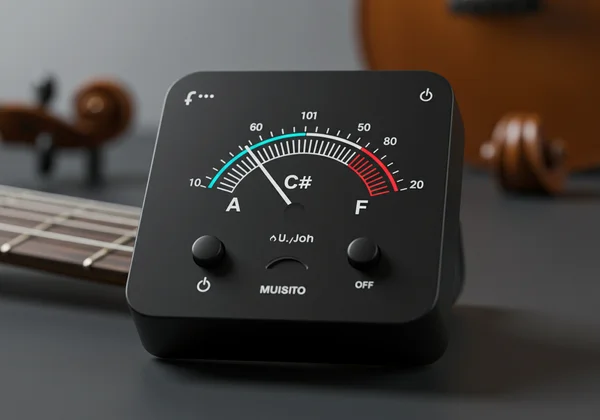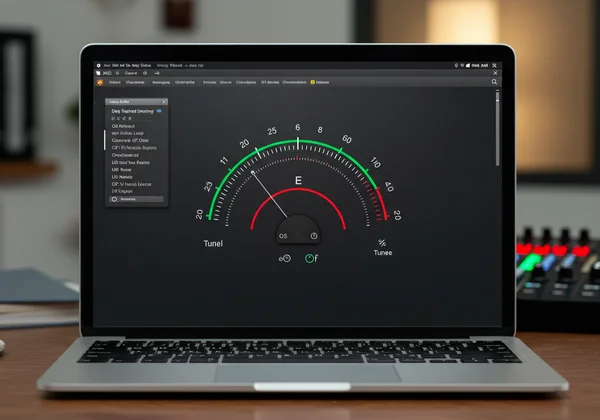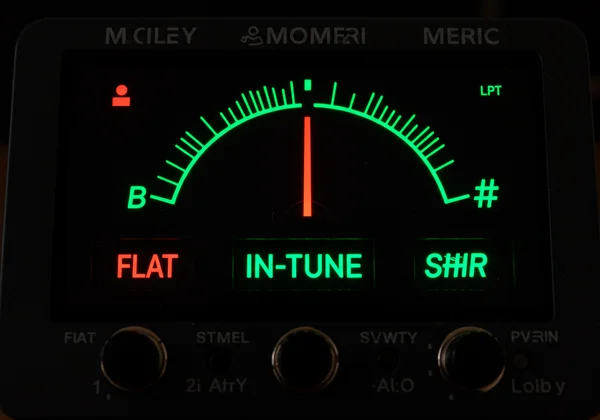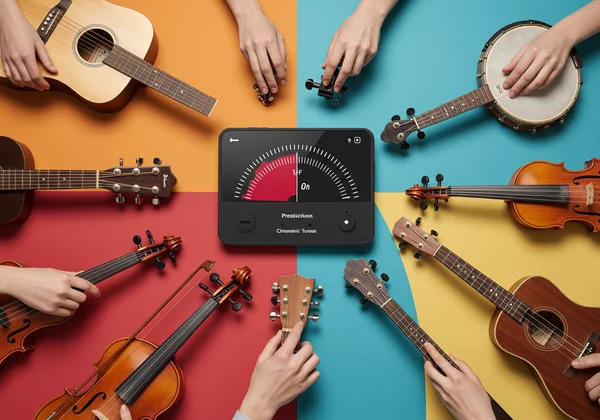Master Your Chromatic Tuner: Tune Any Instrument Online
Achieving perfect pitch for any instrument is now simpler than ever with the right chromatic tuner. This comprehensive guide will show you how to leverage an online chromatic tuner to ensure your guitar, ukulele, violin, or even more unique instruments, are always in tune. How to use a chromatic tuner to its fullest potential is the key to unlocking perfect pitch for any instrument you play. Discover how the professional-grade online instrument tuner at our platform provides the accuracy you need, completely free and directly in your browser.
Whether you're a beginner learning the basics, a gigging musician needing a reliable backup, or a music educator seeking a universal tool for your students, understanding how a chromatic tuner works can fundamentally change how you tune your instruments. Let's dive into the fundamentals and explore the advanced techniques that will empower you to tune with confidence and play with passion.
What is a Chromatic Tuner & Why Our Online Tool Excels
Before you can master a tool, it’s essential to understand its mechanics. A standard guitar tuner might only recognize the six notes of standard tuning (E, A, D, G, B, E), but a chromatic tuner is far more powerful. It detects and displays all 12 pitches of the Western chromatic scale, making it a universal tool for virtually any instrument.
This versatility is why seasoned musicians and teachers prefer a high-quality chromatic tuner. It’s not limited by presets; it simply hears a note and tells you precisely what it is and how close it is to perfect pitch. This makes it ideal for everything from a standard ukulele tuner to a violin tuner, and even for exploring creative alternate tunings.

Understanding Pitch, Frequency, and Cents in Tuning
To get the most out of a chromatic tuner, it helps to know the language of sound. Every note you play has a specific pitch, which corresponds to its audio frequency, measured in Hertz (Hz). For instance, the standard concert pitch for the note 'A' above middle C (A4) is 440 Hz. A chromatic tuner works by measuring the frequency of the sound your instrument produces.
The tuner then shows you how close your note is to the target frequency. This deviation is often measured in cents. One cent is 1/100th of a semitone (the distance between two adjacent notes, like C and C#). When the tuner shows your note is "in tune," it means you are within a very narrow margin of the target frequency—often just +/- 1 cent. This level of precision, based on the A440 concert pitch standard, is crucial for playing harmoniously with other musicians.
The Online Tuner Advantage: Your Free Online Chromatic Tuner
This is where our free online tuner stands out. It provides a professional, highly accurate free online tuner without any compromises. Here’s why it’s the superior choice:
-
Ultimate Convenience: It’s a microphone tuner that works directly in your browser. There is no download required, no app to install, and no registration needed. Just open the page and start tuning.
-
Universal Compatibility: It works on your laptop, desktop, or phone, making it perfect for tuning at home, in the studio, or as an emergency backup at a gig.
-
Crystal-Clear Interface: The visual feedback is intuitive. You don’t need to be a music theory expert to understand if your note is sharp (too high) or flat (too low).
-
Ad-Free Experience: Unlike many free tools, our platform is committed to a clean, distraction-free environment so you can focus solely on your music. Try our free tool and experience the difference.

Step-by-Step: Effectively Using Your Online Chromatic Tuner
Getting a perfect tune is a straightforward process with the right technique. Follow these steps to use the chromatic tuner effectively, whether you're a complete beginner or a seasoned pro looking for a quick refresher. This process ensures you get a stable and accurate reading every time.
These online chromatic tuner tips are designed to help you achieve the best results quickly and efficiently. By following this simple workflow, you can ensure your instrument sounds its best for practice, recording, or performance.
Granting Microphone Access for Accurate Online Tuning
The first and most crucial step is allowing the tuner to hear your instrument. When you visit our website, your browser will prompt you for microphone access. You must click "Allow" for the tuner to function. This is a standard, secure procedure; the website only listens when the page is active to analyze the pitch.
If you accidentally block it, you can usually re-enable access by clicking the lock icon in your browser's address bar and changing the microphone permission for the site. A good connection between your instrument and the device's microphone is key to an accurate tuning experience.
Interpreting the Visual Feedback: Sharp, Flat, or In-Tune?
Once the microphone is active, play a single, clear note on your instrument. The tuner's interface will immediately come to life. You’ll see the name of the closest note it detects (e.g., E, A#, Gb). The visual feedback will guide your adjustments:
- Flat (b): If the needle or indicator is to the left of the center, the note is too low in pitch. You need to tighten the string slightly.
- Sharp (#): If the indicator is to the right of the center, the note is too high. You need to loosen the string slightly.
- In-Tune: When the indicator is perfectly centered and often turns green, you’ve hit the correct pitch.
Always make small, gradual adjustments to avoid over-tightening and breaking a string.

Best Practices for Precise & Stable Tuning Results
For the most accurate reading, follow these professional tips. First, minimize background noise. A quiet environment allows the microphone to isolate your instrument’s sound. Second, pluck the string with consistent force—not too hard, not too soft—and let the note sustain. The tuner listens to the stable part of the note, not the initial attack.
Finally, for geared tuners (like on guitars), always tune up to the note. If your note is sharp, loosen the string so it's slightly flat, then slowly tighten it back up to pitch. This practice helps ensure better tuning stability and prevents the tuning peg from slipping. These small habits can also improve your instrument's intonation tips over time.
Unlocking Custom & Unusual Tunings with Chromatic Precision
What truly unlocks the power of a custom instrument tuning tool like our online tuner is its freedom from presets. While standard tunings are great, a chromatic tuner opens up a universe of sonic possibilities, allowing for creative expression and accommodating instruments from all over the world.
This is where advanced musicians and curious explorers can truly benefit. If you want to play slide guitar, Celtic folk music, or heavy metal, you’ll need to venture into non-standard tunings. Our advanced tuning tool makes this process simple and precise.
Beyond Standard: Exploring Alternate and Open Tunings
Alternate tunings change the relationship between the strings, creating unique chord voicings and drones. With a chromatic tuner, you don’t need to search for a special "Drop D tuner." You simply play your low E string and tighten or loosen it until the tuner reads 'D'.
Popular alternate tunings you can easily achieve include:
- Drop D (DADGBE): A favorite in rock and metal for a heavier sound.
- Open G (DGDGBD): Essential for blues and slide guitar, used by artists like Keith Richards.
- DADGAD: A staple in Celtic and folk music, known for its droney, ethereal quality.
Simply use the tuner to guide each string to its target note, regardless of what it "should" be in standard tuning.
Tuning Instruments Without Specific Presets: The Chromatic Solution
What if you play the banjo, mandolin, cello, or even a less common instrument like a balalaika or a sitar? You don't need to find a dedicated tuner for each one. Our chromatic tuner is the perfect online instrument tuner for any sound-producing source.
As long as the instrument produces a clear, sustained pitch, the tuner can identify it. Just look up the standard tuning notes for your specific instrument and use our tool to match each string. This makes it an invaluable resource for multi-instrumentalists and music educators who work with a variety of instruments. You can confidently tune any instrument with precision.

Advanced Tips for Mastering Your Online Chromatic Tuner
To achieve professional-level accuracy, especially in a noisy environment like a stage or rehearsal room, try these tips. Position your device’s microphone as close to your instrument’s sound source as possible. For acoustic guitars, this is near the soundhole. For electric instruments, you can even play unplugged if it’s quiet enough.
Another pro tip is to check your tuning after putting a capo on. A capo can slightly bend the strings sharp, and a quick touch-up with an online tuner ensures you remain perfectly in tune. This attention to detail separates good musicians from great ones.
Empower Your Music with Our Online Chromatic Tuner
A reliable chromatic tuner is an indispensable tool for any musician. It grants you the freedom to tune a diverse range of instruments with professional accuracy, fostering confidence in your musical journey. Our free, user-friendly online chromatic tuner offers this essential support, always just a click away. Our platform delivers all of this in an accessible and user-friendly package.
Tune with confidence, and let your passion for music shine through in every perfectly pitched note.
Ready to get in tune? Visit our free online chromatic tuner now and experience it for yourself.
Frequently Asked Questions About Chromatic Tuners
How do I use an online chromatic tuner effectively?
To use it effectively, ensure you are in a quiet room, grant microphone access to your browser, and pluck one string at a time with a firm, consistent attack. Watch the visual display to see if the note is flat (too low) or sharp (too high), and adjust the tuning peg until the indicator is centered. For best results, always tune up to the note.
Is an online tuner as accurate as a physical tuner?
Yes, a high-quality online tuner like the one on our site can be just as accurate as many physical clip-on or pedal tuners. The accuracy depends on the quality of the algorithm and your device's microphone. For most applications, from practice to live performance, our online tuner provides professional-grade precision.
Can I tune any instrument with a chromatic tuner?
Absolutely. That is the primary advantage of a chromatic tuner. It detects any of the 12 standard musical pitches, making it suitable for guitar, bass, violin, ukulele, banjo, brass, woodwinds, and even more exotic instruments, as long as they produce a clear tone.
What should I do if my online tuner isn't picking up sound?
First, check that you have granted microphone permissions for the website in your browser's settings. Second, make sure your device's microphone is not muted or covered. Finally, try moving your instrument closer to the microphone and plucking the string a bit louder to ensure the sound is being captured clearly.
Can I use this online tuner to tune my instrument on my phone?
Yes, our website is designed to be fully responsive and works seamlessly on any modern smartphone, tablet, or computer with a web browser and a microphone. There's no need to download a separate app; simply open the website and you can start tuning immediately.